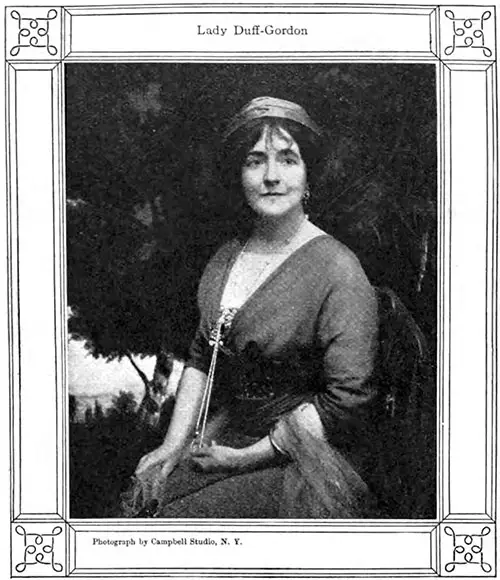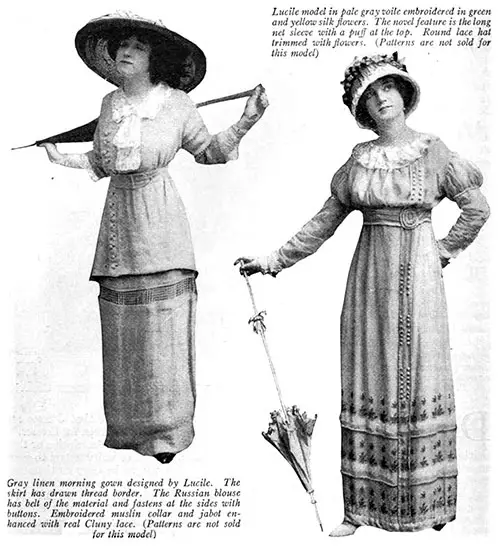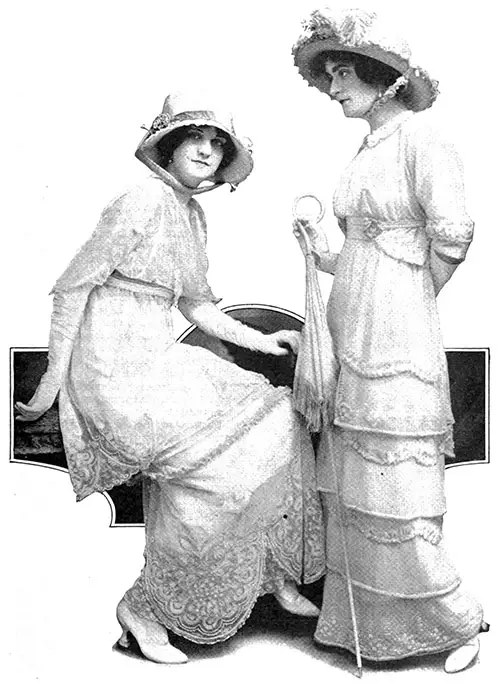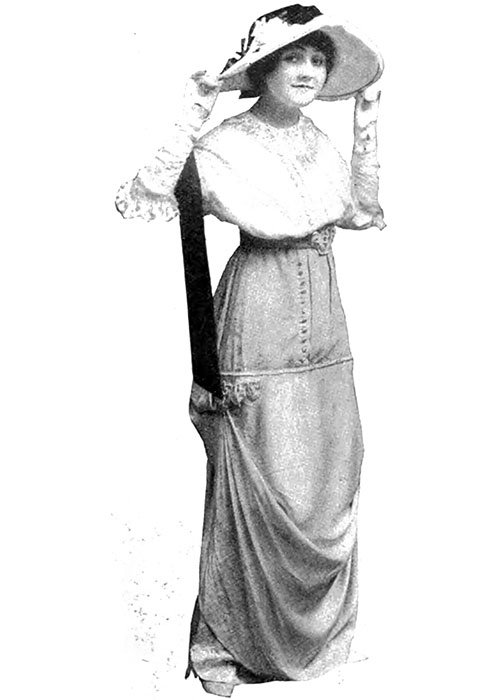Recipe for a Summer Dress 1912

Lady Duff Gordon, photograph by Campbell Studio, N.Y
Dear Mr. Editor:
You have been kind enough to wish me to write a series of fashion articles for you. Here is the first. I am afraid that my papers will not be like the usual fashion discourses, because, odd as it may sound coming from me, I do not believe in fashions!
By that, I mean I do not believe in what is called “the mode,” the uniform dictated arbitrarily by a dressmaker sitting in his Paris atelier and made popular by some mondaine or demi-mondaine, thence to be worn by thousands of women whether it suits them or not, simply because it is “the mode.”
I do not believe in that thoughtless, unintelligent, spendthrift shifting from this to that in dress simply because, overnight, “the fashion” has changed.
I shall never believe that a woman should be a slave to her dresses, and that is what “the fashions” make her. But I do think that dress was made for a woman to form into coverings of such lines and colors as will best set off her charms and her individuality.
In other words, I believe that dresses are made for women, not women for dresses. And so, instead of this description or that description, I want to write letters to your readers which will make clear to them my ideas of the inner meaning of dresses-a distinctly feminine “Sartor Resartus,” perhaps.

Designed by Lucile. The skirt has a drawn thread border. The Russian blouse has a belt of the material and fastens at the sides with buttons. The embroidered muslin collar and jabot are enhanced with real Cluny lace.
Lucile model in pale gray voile embroidered in green and yellow. The novel feature is the long net sleeve with a puff at the top. The round lace hat is trimmed with flowers.
I would like to talk about the importance of simplicity; the folly and the dangers of exaggeration; the absurdity of blindly following “a fashion”; the importance of intelligently studying one’s personality and expressing and interpreting that personality in one’s dresses; the necessity of harmony between oneself and one’s manner of dressing, from the hair down to the boots; the paramount value of right taste in its effect on your fortunes, your everyday life, your happiness.

Garden-party frock by Lucile of tambon lace trimmed with palest pink satin and valenciennes lace. The pale yellow taffeta bonnet is decorated with blue ribbon and a bunch of varicolored flowers.
Summer frock from Lucile in white chiffon and fine lace mounted over shell pink. The belt and trimmings are of the palest pink embroidered with tiny white beads. A smart touch is lent by the pale mauve coat fashioned on bolero lines. The leghorn bonnet is enhanced with violets and a cluster of mauve feathers at the side.
I would like to teach your readers to dare to foster and preserve their individuality. I do not think that it is immodest of me to say that I have won fairly the right to be considered an expert, and as such, I am at least worth hearing.
We may all, each in our own house, invent what we think are the most perfect things. And naturally, we each think ours are the best. However, because we believe they are good does not make them the fashion.
It is one individual that does that—a celebrated beauty in the Faubourg St. Germain, or a favorite actress. She wears the dress, and in some insistent and mysterious manner it catches on to the public taste. Then everybody copies that particular model, and it becomes a uniform. I do not know whether this is a sign of the times, but I fancy not.
Looking back along the past ages of fashions, you see the ladies in all the celebrated pictures of any given period seemingly dressed alike. I think it a great pity!
If my small voice has any weight in these matters, I shall try to induce each woman to study her particular type and figure and, no matter what the fashions are that the dressmakers choose to invent, I shall urge her to stick religiously to her own type.
I am only preaching what I practice myself. I do not know whether any of your readers have ever seen me, but I have one particular style that I always stick to no matter what other people are wearing. I have all my clothes made in that same fashion from year to year, but in different colors and materials.
Someday, Mr. Editor, if you wish it, I will send you a picture of my particular tailor-made coat and skirt which at this moment many of my kind customers in Paris are adopting for their morning airing in the Bois. I have another variation for my afternoon and evening gowns, but they are always of the same style.
Simple, with long lines and no "odds and ends and bits” anywhere. And it is my present intention (but I am only a woman and therefore may change at any moment, but I devoutly hope not) to stick to this fashion until the end of my time, provided (and this is a very serious condition) that I keep slim, and this I am determined to do.
This is not an idea that is original with me; not at all. I always have before me a very dear old aunt of mine who died lately at the age of eighty-nine. When she was forty years old, she adopted a mode of her own and never changed it. You may say that a mode of forty or fifty years ago must have been a fright.

Mauve foulard frock from Lucile trimmed with white satin. The skirt is draped at the side in suggestion of the pannier style, the drapings caught with a buckle of the foulard and satin. A similar buckle fastens the belt of the foulard and satin. Collar and cuffs of valenciennes lace and embroidery. White Tuscan straw hat with black ‘elvet ribbon and large pink rose.
Maybe so, but her individual style was of such simple lines and personal charm and so expressed her personality that with her it always seemed perfect. When she died, we found at the very least fifty dresses all made in the same style, but of different materials. As she got older, she had them made in very thick satins and brocades, instead of the more flimsy materials.
No one would ever have known she was not “in fashion.” The harmony was so fine that she was always in the best of fashion. All this is by the way, but it illustrates what I have said about daring to be free of “the mode.”
You tell me that this article will not appear until the August issue, and that it will then be getting a bit late for summer dresses; also that it is now too early to talk about autumn ones. But, I am going to give you my recipe for a summer dress: “Summer” is a word that always suggests to me complete satisfaction, and delight, and dainty beauty, and a laissez aller in modes, all the most flimsy and the most exquisite fabrics. What more can I say? In my philosophy, the recipe is as good for next summer like this.
Keep in your mind always the idea of a foundation of the palest pink, and the palest pink stockings, and over this drape chiffon, or lace, or voile, or muslin, in your own individual style and in any faint color you like; even in a dark one, providing you keep the pale pink, transparent effect of the foundation. And there you have my ideal summer frock.
Duff-Gordon, Lady "Lucile", "My Recipe for a Summer Dress," in Good Housekeeping Magazine, New York: The Charles Schweinler Press, Vol. LV, No. 2, Whole No. 406, August 1912: 213 - 216.
Note: We have edited this text to correct grammatical errors and improve word choice to clarify the article for today’s readers. Changes made are typically minor, and we often left passive text “as is.” Those who need to quote the article directly should verify any changes by reviewing the original material.
